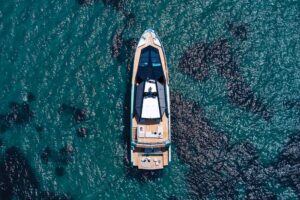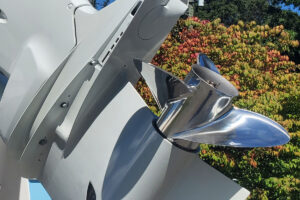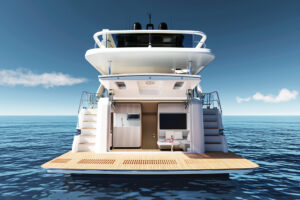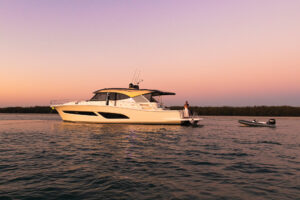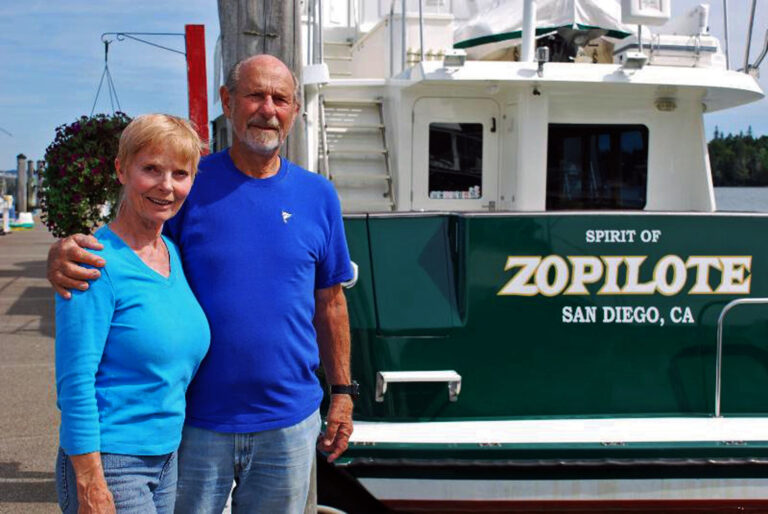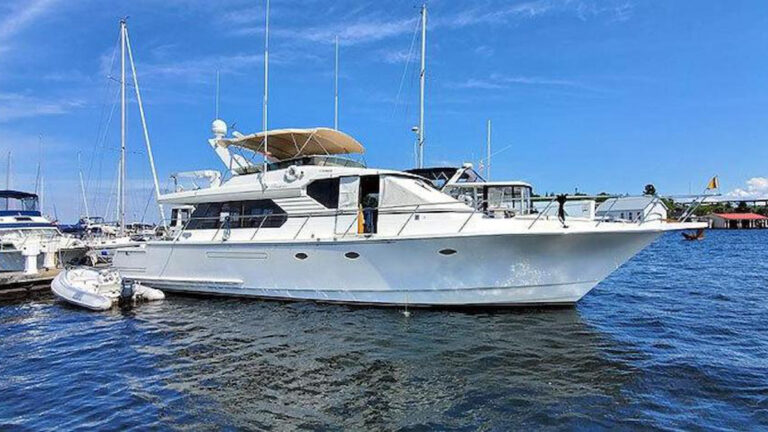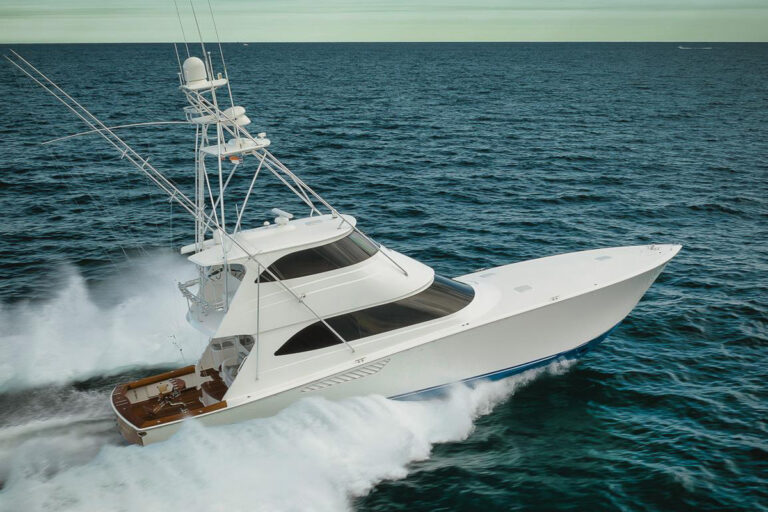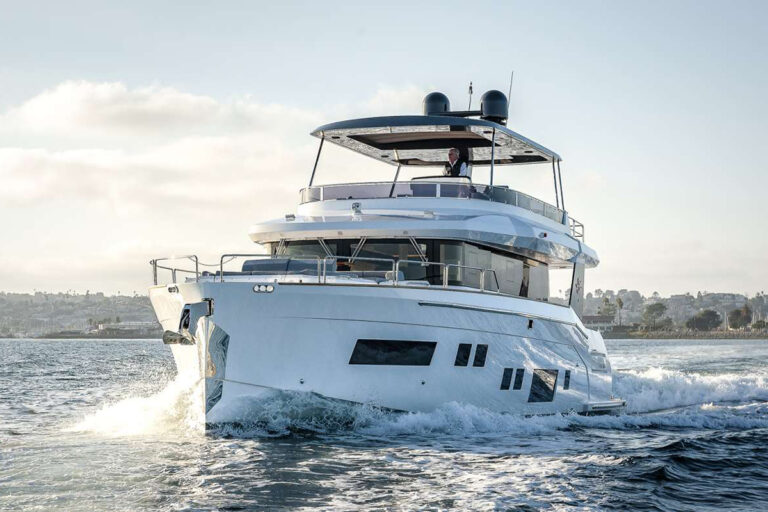The Automatic Identification System (AIS) transponder required on all large commercial vessels provides navigators with a superior collision-avoidance system and greatly facilitates communication between vessels and with the Vessel Traffic Service systems used in harbors and ports. While AIS is not presently required on any U.S.-flagged recreational vessel, the quality of the navigation information it provides makes it a very attractive device to consider installing on your yacht. Chances are good that AIS will become more popular in the very near future. Simrad, ACR, JCR, McMurdo, Sealinks and Furuno all make Class A units. My test of the Furuno F100 Class “A” AIS on board our ketch made me wish it was a permanent part of my navigation electronics suite.
The AIS receives and processes the data transmitted from all equipped vessels in VHF radio range and automatically transmits “own ship” information to other vessels and shore stations. The information gathered by the AIS was presented on the FA 100’s LCD screen and can also be displayed on a vessel’s radar/chart plotter screen. The initial display shows the relative bearing and distance of all in-range AIS-equipped vessels. Positioning the cursor on a selected target discloses the “other” vessel’s name, MMSI (Maritime Mobile Service Identity), course, position, speed, velocity vector, classification (type of vessel), maneuvering information, closest point of approach (CPA) and time to closest point of approach (TCPA). The “other vessels” data will also include type of vessel, length, breadth, draft, destination and whether it is carrying hazardous cargo. Connecting the AIS to the radar changes previously unspecific targets on the screen to uniquely identified vessels. Your radio call to “ship on my port bow at three miles” can now be done with either a voice call using the vessel’s name or a DSC call using the vessel’s MMSI. Connecting the AIS to a computer allows you to exchange short, safety-related E-mail messages between vessels. Although the detailed exchange of navigation data might not be critical in the open sea, its value when under way in a busy, fog-shrouded harbor can be inestimable.
A Class “A” AIS like the FA 100 is densely packed with electronics; one VHF transmitter, two VHF TDMA (digital-signal) receivers, one VHF DSC receiver and the interface equipment needed to accept information from the vessel’s sensors and supply NMEA 0183 data to the radar and chart plotter. The unit lists for about $5,795 and has a street price of just under $4,000. A complete installation requires a VHF antenna and connections to the vessel’s data bus.
AIS is designed to function without need for a master control, making it useful everywhere. Since a large number of AIS-equipped vessels are present in major port areas, the Self-Organizing Time Division Multiple Access (SOTDMA) system offers interference-free exchanges by providing a total of 2,250 time slots in each minute. Each vessel’s report is sent in one slot in less than 3/100 of a second.
A Class “A” AIS broadcasts information every 2 to 10 seconds when the vessel is under way and every three minutes while at anchor. During my evaluation of the FA 100, I viewed the AIS reports from various vessels transiting the Tampa Bay entrance channel and from vessels in the offshore anchorage area. I learned each vessel’s MMSI, navigation status (typically under way using engine), speed over ground to 0.1 knots, lat/long, true course ±0.1 degree, heading and rate of turn. Every 6 minutes the vessel’s broadcast included its IMO number, radio call sign, name, type of vessel (I was reporting as a pleasure craft), dimensions to the nearest meter, draught in meters, destination and ETA-and even the precise location of the vessel’s GPS antenna (when dealing with a ship that can be 300 meters long, knowing exactly where the position reference point is located can be important navigation information for another close-by vessel).
While the full-blown Class “A” AIS I tested would be very nice to have on board, this level of capability exceeds what is needed for cooperative navigation among small vessels, yachts and large ships. A drafting committee that includes representatives of the yachting community expects to finalize a Class “B” AIS specification before the end of 2005. The present plan envisions three levels of “B” equipment. Professional Class “B,” (a Class “A” unit with some specifications relaxed somewhat), Standard Class “B” (providing most of the capabilities of an “A”) and Basic Class “B,” intended for small craft and specially designed for use by inexperienced operators. In its most basic form the Basic “B” unit would have only one control, a power switch, and would have no display. Other vessels would “see” the Basic B-equipped vessel on their AIS and it would be evident that the signal was from a small craft. At present the plan is for a Class “B” AIS to report less often than an “A” unit, perhaps every 30 seconds when operating at less than 14 knots. Depending on the final specification for the data output stream, even the most basic “B” could provide all of the “other vessel” information when connected to a compatible radar/chart plotter.
Yachts and small craft have a greater need to know about and avoid big ships than the reverse. Even in open water, and regardless of the rules of the road, a 1,000-plus-foot-long tanker can’t take evasive action to avoid a too-close approach to your yacht. This need can be met with a receive-only AIS that processes other vessel’s AIS broadcasts for display on the yacht’s radar or chart plotter. Such a receiver can provide the full array of AIS information at a lower cost than even a basic “B” unit (although a large percentage of the cost of the AIS is in the receivers, not the transmitter). Equipment of this type is currently available. I believe that owners will voluntarily equip their yachts with AIS once they become familiar with the system’s substantial navigation safety benefits.
A virtually real-time view of the information being exchanged between AIS-equipped vessels in many of the world’s ports can be seen on the AISLive.com Web site (www.AISLive.com). A check of the Panama Canal area provided data on 76 vessels with much of the data less than two minutes old. A short time spent viewing the display will convince you of the value of AIS and satisfy your armchair-admiral ambition for today.
AIS Carriage Requirements International law requires that every large commercial vessel (over 50,000 gross tons) sailing the world’s oceans be equipped with an AIS. Commercial vessels of more than 300 gross tons must be equipped not later than July 1, 2007. The U.S. Coast Guard also requires the AIS on certain other commercial vessels. Under current U.S. law (The Recreational Boating Safety Act) the Coast Guard is prohibited from mandating carriage of AIS or any other radio equipment on recreational vessels.

